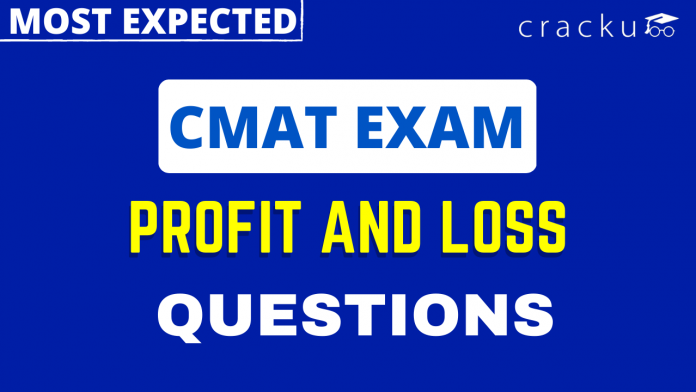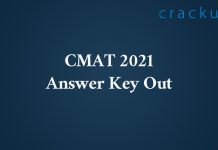CMAT Profit and Loss Questions [Download PDF]
Download Profit and Loss Questions for CMAT PDF – CMAT Profit and Loss questions PDF by Cracku. Practice CMAT solved Profit and Loss Questions paper tests, and these are the practice question to have a firm grasp on the Profit and Loss topic in the XAT exam. Top 20 very Important Profit and Loss Questions for CMAT based on asked questions in previous exam papers. Click on the link below to download the Profit and Loss Questions for CMAT PDF with detailed solutions.
Download Profit and Loss Questions for CMAT
Enroll to CMAT 2023 Crash Course
Question 1: Mayank buys some candies for Rs 15 a dozen and an equal number of different candies for Rs 12 a dozen. He sells all for Rs 16.50 a dozen and makes a profit of Rs 150. How many dozens of candies did he buy altogether?
a) 50
b) 30
c) 25
d) 45
1) Answer (A)
Solution:
Let the number of dozens of candies he bought of each variety be x
Hence total cost = 12x + 15x = 27x
Total selling price = 16.50*2x = 33x
Profit = 33x – 27x = 6x
Given 6x = 150 => x = 25
Hence he bought 50 dozens of candies in total
Question 2: The manufacturer of a table sells it to a wholesale dealer at a profit of 10%. The wholesale dealer sells the table to a retailer at a profit of 30% Finally, the retailer sells it to a customer at a profit of 50%. If the customer pays Rs 4290 for the table, then its manufacturing cost (in Rs) is
a) 1500
b) 2000
c) 2500
d) 3000
2) Answer (B)
Solution:
Let the manufacturing price of the table = $x$
Hence the price at which the wholesaler bought from the manufacturer = $1.1 \times x$
The price at which the retailer bought from the wholesaler = $1.3 \times 1.1 \times x$
The price at which the customer bought from the retailer = $1.5 \times 1.3 \times 1.1 \times x$
$1.5 \times 1.3 \times 1.1 \times x = 4290$
=> x = 2000
Question 3: If Fatima sells 60 identical toys at a 40% discount on the printed price, then she makes 20% profit. Ten of these toys are destroyed in fire. While selling the rest, how much discount should be given on the printed price so that she can make the same amount of profit?
a) 30%
b) 25%
c) 24%
d) 28%
3) Answer (D)
Solution:
Let the cost price be C and the marked price be M.
Given,
0.6 M = 1.2 C
M = 2C
CP of 60 toys = 60C
Now only 50 are remaining.
Hence,
M (1 – d) * 50 = 72C
1- d = 0.72
d = .28
Hence 28%
Question 4: Suppose, C1, C2, C3, C4, and C5 are five companies. The profits made by Cl, C2, and C3 are in the ratio 9 : 10 : 8 while the profits made by C2, C4, and C5 are in the ratio 18 : 19 : 20. If C5 has made a profit of Rs 19 crore more than C1, then the total profit (in Rs) made by all five companies is
a) 438 crore
b) 435 crore
c) 348 crore
d) 345 crore
4) Answer (A)
Solution:
Given,
C1 : C2 : C3 = 9 : 10 : 8 … i
C2 : C4 : C5 = 18 : 19 : 20 … ii
Let’s multiply i by 9 and ii by 5
C1 : C2 : C3 = 81 : 90 : 72
C2 : C4 : C5 = 90 : 95 : 100
Therefore, C1 : C2 : C3 : C4 : C5 = 81 : 90 : 72 : 95 : 100
Given,
100x – 81x = 19
x = 1
Hence, total profit = 100 + 95 + 72 + 90 + 81 = 438
Question 5: If a seller gives a discount of 15% on retail price, she still makes a profit of 2%. Which of the following ensures that she makes a profit of 20%?
a) Give a discount of 5% on retail price.
b) Give a discount of 2% on retail price.
c) Increase the retail price by 2%.
d) Sell at retail price.
5) Answer (D)
Solution:
Let the retail price be M and cost price be C.
Given,
0.85 M = 1.02 C
M = 1.2 C
If he wants 20% profit he has to sell at 1.2C, which is nothing but the retail price.
Question 6: Rohit bought 20 soaps and 12 toothpastes. He marked-up the soaps by 15% on the cost price of each, and the toothpastes by Rs.20 on the cost price each. He sold 75% of the soaps and 8 toothpastes and made a profit of Rs.385. If the cost of a toothpaste is 60% the cost of a soap and he got no return on unsold items, what was his overall profit or loss?
a) Loss of Rs.355
b) Loss of Rs.210
c) Loss of Rs.250
d) None of the above
6) Answer (A)
Solution:
Let the CP of 1 soap = S
Thus, the CP of 1 toothbrush = 0.6S
Given that, SP of 1 soap = 1.15 S and SP of 1 toothbrush = 0.6S+20
Also, 15*1.15*S + 8*(0.6S+20) – 15S – 8*0.6*S = 385
Thus, solving we get S = 100
Hence, Total CP of 20 soaps and 12 toothbrush = 20*100 + 12*60 = 2720
SP of 15 soaps and 8 toothbrush = 15*1.15*100 + 8*80 = 2365
Thus, the overall loss = 2365 – 2720 = 355 Rs.
Hence, option A is the correct answer.
Instructions
Books and More sells books, music CDs and film DVDs. In December 2009, they earned 40% profit in music CDs and 25% profit in books. Music CDs contributed 35% towards their total sales in rupees. At the same time total sales in rupees from books is 50% more than that of music CDs.
Question 7: If Books and More made 50% loss in film DVDs, then overall they made
a) 12.3% profit
b) 8. 7% profit
c) 0.4% loss
d) 6.25% loss
7) Answer (B)
Solution:
Let total selling price of books and more = $Rs. 100x$
Thus, S.P. of music CDs = $\frac{35}{100} \times 100x = 35x$
S.P. of books = $35x + \frac{50}{100} \times 35x = 52.5x$
=> S.P. of DVDs = $100x – 35x – 52.5x = 12.5x$
40% profit is earned in music CDs and 25% profit in books.
=> C.P. of music CDs = $\frac{100}{140} \times 35x = 25x$
and C.P. of books = $\frac{100}{125} \times 52.5x = 42x$
It is given that Books and More made 50% loss in film DVDs
=> C.P. of DVDs = $\frac{100}{50} \times 12.5x = 25x$
Thus, total C.P. of books and more = $25x + 42x + 25x = 92x$
$\therefore$ Profit made by books and more = $\frac{100x – 92x}{92x} \times 100$
= $\frac{8}{92} \times 100 = 8.69 \% \approx 8.7 \%$
Question 8: If Books and More have earned 20% profit overall, then in film DVDs they made
a) 15.2% profit
b) 10.0% profit
c) 10.0% loss
d) 16.3% loss
e) 23.4% loss
8) Answer (E)
Solution:
Let total cost price of Books and More = $RS. 100x$
It is given that Books and More have earned 20% profit overall
=> Total S.P. = $\frac{120}{100} \times 100x = 120x$
Thus, S.P. of music CDs = $\frac{35}{100} \times 120x = 42x$
S.P. of books = $42x + \frac{50}{100} \times 42x = 63x$
=> S.P. of DVDs = $120x – 42x – 63x = 15x$
40% profit is earned in music CDs and 25% profit in books.
=> C.P. of music CDs = $\frac{100}{140} \times 42x = 30x$
and C.P. of books = $\frac{100}{125} \times 63x = 50.4x$
=> C.P. of DVDs = $100x – 30x – 50.4x = 19.6x$
=> Loss made on DVDs = $19.6x – 15x = 4.6x$
$\therefore$ Loss % on DVDs = $\frac{4.6 x}{19.6 x} \times 100 = 23.46 \%$
Question 9: A dealer buys dry fruits at Rs. 100, Rs. 80 and Rs. 60 per kilogram. He mixes them in the ratio 3 : 4 : 5 by weight, and sells at a profit of 50%. At what price per kilogram does he sell the dry fruits?
a) Rs. 80
b) Rs. 100
c) Rs. 95
d) None of these
9) Answer (D)
Solution:
Let’s say he buy fruits of weights 3 kg., 4kg., 5 kg.
Total kilograms of dry fruits $=3+4+5=12$
Overall cost price $=3\cdot100+4\cdot80+5\cdot60=300+320+300=920$
So cost price per kg. $=\dfrac{300+320+300}{12} = \dfrac{920}{12}$
Selling price = $\dfrac{920}{12} \times \dfrac{3}{2}$ = 115 per kg (Since Profit is 50%)
Hence answer will be D.
Question 10: I sold two watches for Rs. 300 each, one at the loss of 10% and the other at the profit of 10%. What is the percentage of loss(-) or profit(+) that resulted from the transaction?
a) (+)10
b) (-)1
c) (+)1
d) (-)10
10) Answer (B)
Solution:
Selling price of first watch = 300
Profit = 10%
cost price = $\frac{300}{1.1}$
Selling price of second watch = 300
Loss = 10%
cost price = $\frac{300}{0.9}$
Total selling price of transaction= 600
Total cost price of transaction = $300(\frac{10}{11} + \frac{10}{9}) = 600 (\frac{100}{99})$
Loss = $600 (\frac{100}{99} – 1)$
%loss = $(600 (\frac{100}{99} – 1)) \div (600(\frac{100}{99})) \times 100 = 1$
Question 11: Rajnish bought an item at 25% discount on the printed price. He sold it at 10% discount on the printed price. What is his profit in percentage?
a) 10
b) 15
c) 17.5
d) 20
e) None of the above
11) Answer (D)
Solution:
Let printed price be 100.
Rajnish bought it at 25% discount, C.P of Rajnish = 75% of 100 = 75.
He sold it at 10% discount on printed price, S.P of Rajnish = 90% of 100 = 90
Hence, Rajnish, profit% = $\ \frac{\ 90-75}{75}\times\ 100=20%$.
The answer is option D.
Question 12: If the cost price is 80% of the selling price, then what is the profit in percentage?
a) 20%
b) 25%
c) 16%
d) 22.5%
12) Answer (B)
Solution:
Given, cost price is 80% of selling price
C.P = 0.8 S.P
Profit = $\ \frac{\ S.P\ -\ C.P}{C.P}\times\ 100$
= $\ \frac{\ S.P\ -\ 0.8S.P}{0.8S.P}\times\ 100$
=$\ \frac{0.2}{0.8}\times\ 100$
= 25%
Answer is option B
Question 13: If the cost price of 20 articles is equal to the selling price of 25 articles, then the
percentage profit or loss made is_______.
a) 20% profit
b) 25% loss
c) 25% profit
d) 20% loss
13) Answer (D)
Solution:
Let the cost price of one article be C.P and selling price of one article be S.P
It is given that,
20C.P = 25S.P
Loss% = $\ \frac{\ C.P-S.P}{C.P}\times100$ = $\ \ \frac{\ \frac{5}{4}S.P-S.P}{\frac{5}{4}S.P}\times\ 100\ $ = 20%
Answer is option D.
Question 14: Same item is sold for Rs. 600 and Rs. 175, respectively. The profit earned on the first sale is 20 times the loss incurred on the second sale. To make a profit of 30% in the second transaction, at what price the second sale should happen:
a) Rs. 310 approx
b) Rs. 238 approx
c) Rs. 254 approx
d) Rs. 357 approx
14) Answer (C)
Solution:
Let the CP be x
Now as per question, $600-x=20\left(x-175\right)$
21x = 4100
x= 195.24
Therefore, to make a profit of 30% selling price of second article should be = $1.3\times\ 195.24\ =\ 253.81$
Question 15: Sheela purchases two varieties of apples – A and B – for a total of Rupees 2800. Theweights in kg of A and B purchased by Sheela are in the ratio 5 : 8 but the cost perkg of A is 20% more than that of B. Sheela sells A and B with profits of 15% and 10%respectively.
What is the overall profit in Rupees?
a) 340
b) 600
c) 240
d) 480
e) 380
15) Answer (A)
Solution:
The two types of apples sold A and B are bought in the ratio of 5: 8.
Considering the weights to be 5x and 8x.
The cost price of A is 20 percent higher than that of B.
Considering the cost price of B = y, A = 6y/5.
The total cost price of A = $\left(5x\right)\cdot\left(\frac{6y}{5}\right)$
The total cost price of B = $\left(8x\right)\cdot\left(y\right)$
THe total cost price = 8xy + 6xy = 14xy
14xy = 2800.
xy = 200.
THe cost price of A = 1200.
THe cost price of B = 1600.
A is sold a profit of 15 percent. 15 percent of 1200 = 180.
B is sold at a profit of 10 percent. 10 percent of 1600 = 160.
The total profit is 180 + 160
= 340
Question 16: Anil, Bobby, and Chintu jointly invest in a business and agree to share the overall profit in proportion to their investments. Anil’s share of investment is 70%. His share of profit decreases by ₹ 420 if the overall profit goes down from 18% to 15%. Chintu’s share of profit increases by ₹ 80 if the overall profit goes up from 15% to 17%. The amount, in INR, invested by Bobby is
a) 2000
b) 2400
c) 2200
d) 1800
16) Answer (A)
Solution:
Let the amount invested by Anil Bobby and Chintu be x, y, and z.
Considering x+y+z = 100*p.
Given Anil’s share was 70 percent = 70*p.
As per the information provided :
His share of profit decreases by ₹ 420 if the overall profit goes down from 18% to 15%.
Since the profits are distributed in the ratio of their investments :
With a 3% decrease in the profits the value of profit earned by A decreased by Rs 420 which was 70 percent of the total invested.
Hence for all three of them would be combinedly losing $\left(420\right)\cdot\left(\frac{10}{7}\right)\ =\ 600$
Hence 3 percent profit was equivalent to Rs 600.
The initial investment is equivalent to Rs 20000.
This is the total amount invested.
Chintu’s profit share increased by Rs 80 when the profit percentage increased by 2 %. A 2 percent increase in profit is equivalent to Rs 20000*2/100 = Rs 400.
Of which Rs 80 is earned by Chintu which is 20% of the total Rs 400.
Hence he invested 20% of the total amount.
Bobby invested the other 10 percent.
10 percent of Rs 20000 = Rs 2000
Question 17: Raj invested ₹ 10000 in a fund. At the end of first year, he incurred a loss but his balance was more than ₹ 5000. This balance, when invested for another year, grew and the percentage of growth in the second year was five times the percentage of loss in the first year. If the gain of Raj from the initial investment over the two year period is 35%, then the percentage of loss in the first year is
a) 5
b) 15
c) 17
d) 10
17) Answer (D)
Solution:
Raj invested Rs 10000 in the first year. Assuming the loss he faced was x%.
The amount after 1 year is 10,000*(1 – x/100). = 10000 – 100*x.
Given the balance was greater than Rs 5000 and hence x < 50 percent.
When Raj invested this amount in the second year he earned a profit which is five times that of the first-year percentage.
Hence the amount after the second year is : (10000 – 100x)(1+$\frac{\left(5\cdot x\right)}{100}$).
Raj gained a total of 35 percent over the period of two years and hence the 35 percent is Rs 3500.
Hence the final amount is Rs 13,500.
(10000 – 100x)(1+$\frac{\left(5\cdot x\right)}{100}$) = 13,500
$\left(100+5\cdot x\right)\cdot\left(100\ -\ x\right)\ =\ 13500$
10000 – 100*x +500*x – 5*$x^2$ = 13500.
$5x^2-400x+3500\ =\ 0$
Solving the equation the roots are :
x = 10, x = 70.
Since x < 50, x = 10 percent.
Question 18: Amal purchases some pens at ₹ 8 each. To sell these, he hires an employee at a fixed wage. He sells 100 of these pens at ₹ 12 each. If the remaining pens are sold at ₹ 11 each, then he makes a net profit of ₹ 300, while he makes a net loss of ₹ 300 if the remaining pens are sold at ₹ 9 each. The wage of the employee, in INR, is
18) Answer: 1000
Solution:
Let the number of pens purchased be n. Then the cost price is 8n. The total expenses incurred would be 8n+W, where W refers to the wage.
Then SP in the first case = $12\times\ 100+11\times\ \left(n-100\right)$
Given profit is 300 in this case: 1200+11n-1100-8n-W=300 =>3n-W = 200
In second case: 1200+9n-900-8n-W=-300 (Loss). => W-n = 600.
Adding the two equations: 2n = 800
n = 400.
Thus W = 600 + 400 = 1000
Question 19: A shopkeeper claims to sell rice at cost price. He uses a false weight with the intention of selling rice at 25% profit. After selling Rice to a customer, he realizes that the customer has paid 10% less than what he should have paid. What is the actual profit percentage made by the shopkeeper?
a) 6.25%
b) 10%
c) 12.5%
d) 15%
19) Answer (C)
Solution:
Let cost price be 1000 per Kg of rice
Now to make 25% profit at 1000
He will sell 800 gm of rice
Now C.P of 800 gm of rice = 800
Now he sold at 10% less than 1000 so S.P = 900
Now therefore profit = $\frac{900-800}{800}\times\ 100\ =\ \frac{100}{8}=12.5\ \%$





